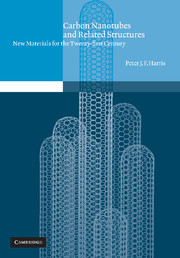Book contents
- Frontmatter
- Contents
- Acknowledgements
- 1 Introduction
- 2 Synthesis: Preparation methods, growth mechanisms and processing techniques
- 3 Structure
- 4 The physics of nanotubes
- 5 Nanocapsules and nanotest-tubes
- 6 The ultimate carbon fibre? The mechanical properties of carbon nanotubes
- 7 Curved crystals, inorganic fullerenes and nanorods
- 8 Carbon onions and spheroidal carbon
- 9 Future directions
- Name index
- Subject index
6 - The ultimate carbon fibre? The mechanical properties of carbon nanotubes
Published online by Cambridge University Press: 28 January 2010
- Frontmatter
- Contents
- Acknowledgements
- 1 Introduction
- 2 Synthesis: Preparation methods, growth mechanisms and processing techniques
- 3 Structure
- 4 The physics of nanotubes
- 5 Nanocapsules and nanotest-tubes
- 6 The ultimate carbon fibre? The mechanical properties of carbon nanotubes
- 7 Curved crystals, inorganic fullerenes and nanorods
- 8 Carbon onions and spheroidal carbon
- 9 Future directions
- Name index
- Subject index
Summary
Finally, under a scanning electron microscope, the last struts would
be replaced by the last set of sub-sub-miniature Tensegrity Masts,
down at the order of size where we speak of an atom's diameter….
The last tensile wires will be simply the chemical bonds.
Hugh Kenner, Bucky: A Guided Tour of Buckminster FullerThe sp2 carbon–carbon bond in the basal plane of graphite is the strongest of all chemical bonds, but the weakness of the interplanar forces means that ordinary graphite is of little value as a structural material. One way in which the great strength of the sp2 bonds can be exploited practically is through the use of fibres in which all the basal planes run approximately parallel to the axis. Carbon fibres with this structure have been produced for many years, and are now widely used as components of composite materials in applications ranging from golf clubs to military aircraft (6.1–6.4). These conventional carbon fibres, which are prepared by the controlled pyrolysis of various precursors, possess very high stiffness and strength, but their properties still fall well short of the theoretical maxima owing to structural imperfections. When fullerene-related carbon nanotubes were discovered in 1991, their highly perfect structure prompted speculation about their potential as ‘super-strong’ carbon fibres. Early theoretical work by David Tomanek and his colleagues from Michigan State University (6.5) confirmed that nanotubes should possess exceptional mechanical properties, and in fact should have a higher rigidity than that of any known material. Experimental confirmation of this has proved more difficult, for obvious reasons: the stress–strain behaviour of structures with diameters of the order of 10nm clearly cannot be tested using conventional techniques.
- Type
- Chapter
- Information
- Carbon Nanotubes and Related StructuresNew Materials for the Twenty-first Century, pp. 186 - 212Publisher: Cambridge University PressPrint publication year: 1999
- 2
- Cited by



